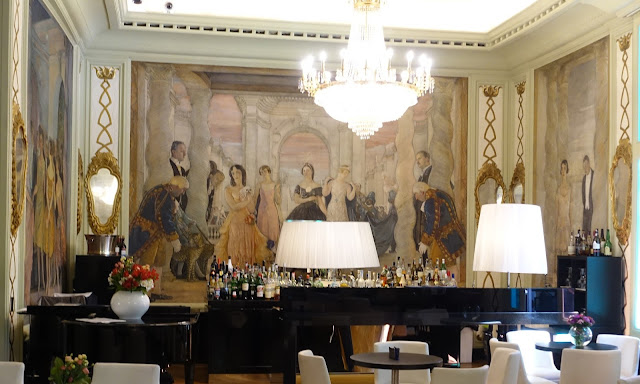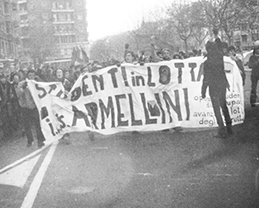The elite of Rome in the mid-1920s, including Mussolini's Jewish mistress, are still on display in a hotel dining room on via Veneto.
The frescoes of Guido Cadorin, a Venetian called to Rome to decorate the large room, have been restored to their original vibrancy and are easy to stop in and see any time--whether or not you are dining or staying in the hotel. We wrote about these gorgeous paintings 7 years ago, as part of our RST Top 40 (#28). And, yet, when we went back this year, they were better than ever. We were fortunate to have the room to ourselves and take good photographs. (That
2010 post has some additional information not included here.)
 |
| The Cadorin Salon/Dining Room - one side. |
The style is "Liberty," Italy's version of Art Nouveau merging into Art Deco. And in the hands of this artist, these beautifully dressed men and women of Fascist Rome come to life.
"Fiammetta and I wanted to pass into immortality in the salon's frescoes," explained the mistress,
Margherita Sarfatti, of the painting of her and her daughter. Although Margherita merited a place on the salon's walls--she was a journalist and art critic--her role as Mussolini's mistress perhaps led to Cadorin portraying her with "denti stretti," as some have said - gritted teeth or a fake smile--and in the background.
 |
Sarfatti and her daughter are the two women in the
background. |
 |
| Margherita Sarfatti |
Other notable figures in the painting include the wife of one of the architects of the hotel, Marcello Piacentini, the most prominent and prolific of Fascist architects, and the painter Felice Carena. The figures on these walls seem oblivious to the Fascist politics from which they were benefiting. That painted obliviousness had a cost, however. A few months after the inauguration of the salon paintings, an official statement from the hotel said that there were some who were disturbed by the paintings and that they therefore covered them with draperies; the cover-up lasted until after the end of World War II. The explanation given now is that the paintings omitted a central figure in Fascism, Mussolini. (There's a different explanation in
our 2010 post, also involving Mussolini.)
One can also note some unusual figures in the paintings, including dark-skinned men in exotic costumes and the woman smoking, looking aggressively outward with her cigarette hanging out of her mouth (see Bill's
review of "Fumo: Italy's Love Affair with the Cigarette."). The architectonic details in the paintings are by Cadorin's brother-in-law Brenno Dal Giudice. Between the two painters, the paintings flow around the doorways and windows of the salon (see the bottom photo).
For the first time we were able to find a written explanation of the frescoes, and identification of some of the people. Ask at the front desk. They don't have extra copies, and it's in Italian, but it's worthwhile to consult this several page explanation while you look at the paintings.
 |
| Smoking woman. |
 |
| Exotic figure. |
We included the Cadorin Salon in our first book,
Rome the Second Time, as part of Itinerary 5: The Nazis and Fascists in Central Rome. The salon is even more accessible now, with the paintings easier to see.
Don't miss this gem at #70 Via Veneto, now the Grand Hotel Palace.
More photos below.
Dianne
 |
| Having the room to ourselves. |
 |
| Figures painted around the door opening. |









